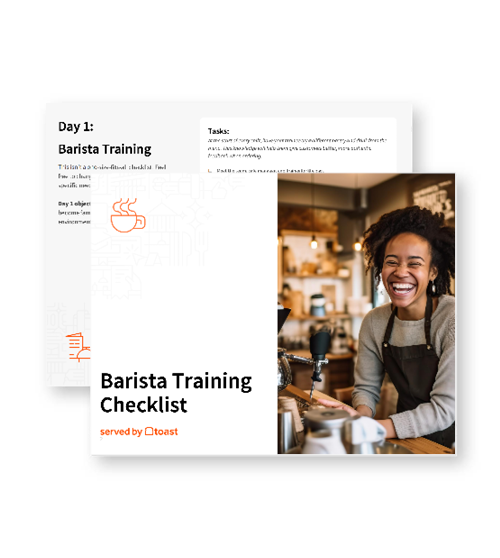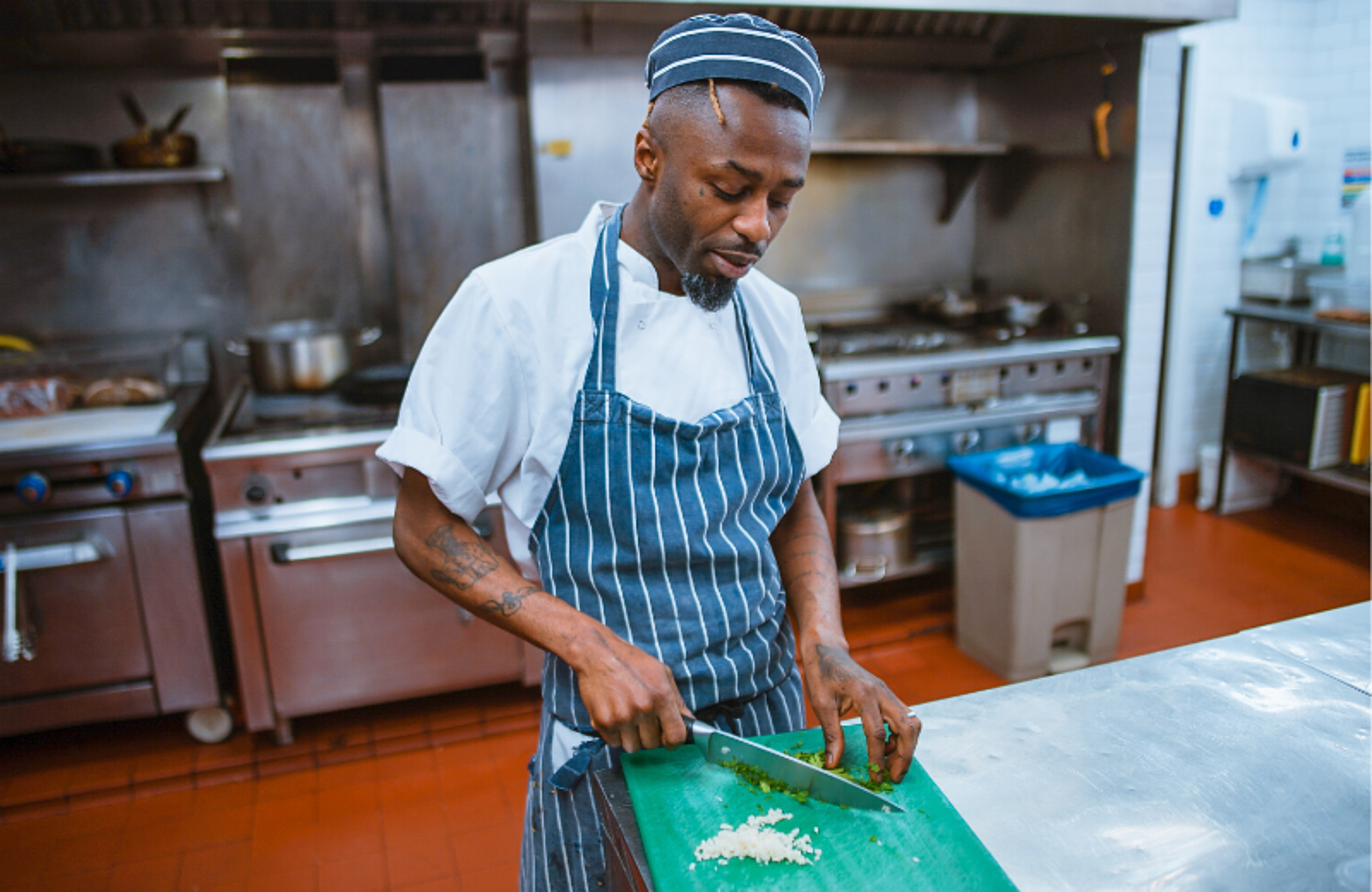
How to Calculate Your Restaurant Labor Cost Percentage
Learn to calculate restaurant labor cost by hours worked, labor cost as a percentage of revenue, and labor cost as a percentage of restaurant operating costs.

Justin GuinnAuthor
Christopher McNuttSenior Product Manager for HR, Restaurant365


Restaurant Labor Cost Calculator
Unlock the power of data-driven labor management with our free Restaurant Labor Cost Calculator. Stop guessing and start optimizing your staffing decisions today.
Get free downloadHow do you calculate labor cost in a restaurant?
Restaurant labor cost describes the total dollar amount your restaurant spends on labor, including pay for salaried and hourly workers, as well as taxes and employee benefits.
Restaurant labor cost percentages are an essential measure for the overall health and potential profitability of an operation.
Restaurant employee churn is typically high given the perceived transient nature of work in the restaurant industry — though operators we’ve surveyed are working to change that perception.
Regardless, a lack of employee retention can amplify the existing restaurant staffing shortages. All this pressure is making labor cost and labor cost percentage critical to monitor and control. It's right there with your cost of goods sold (COGS) as a critical component of operating costs.
In this article, you will learn how to calculate restaurant labor costs and why it’s helpful to turn that into labor cost percentages. Take a look at how operators can automate these critical calculations with restaurant management tools, such as payroll, scheduling software, and other restaurant business tools.
What is a good labor cost percentage for a restaurant?
A good labor cost percentage is around 30% of gross revenue, which should be about half of your restaurant prime costs (with COGS making up the other half).
What are common restaurant operating costs?
Restaurants have two main buckets for operating costs: fixed costs and variable costs.
Fixed costs include rent, insurance, and other standard monthly or annual costs that don't regularly fluctuate.
Variable costs include restaurant food costs — or cost of goods sold (COGS) — and restaurant labor costs. COGS and labor costs added together are known as your restaurant prime costs.
Along with fixed and variable costs, new restaurants also have start-up costs to consider, such as new equipment, physical improvements, and probably marketing materials like a website. But start-up costs won’t be factored into your standard operating costs.
What makes up restaurant labor costs?
Restaurant labor cost describes the total dollar amount your restaurant spends on labor, including pay for salaried and hourly workers, as well as taxes and employee benefits.
The amount restaurant owners spend on labor also affects your prime cost – the total cost of goods sold plus total labor cost – which is the metric that many restaurateurs use to examine their restaurant’s efficiency.
New restaurateurs may be surprised to learn that labor cost includes more than just their restaurant staff’s hourly wages. Here are some other things that factor into your labor cost calculation:
Hourly employee wages
Salaried employee wages (tricky because salaries technically fall into fixed costs, but they also obviously roll up to labor costs)
Premium pay (Overtime, double time, tip make up and other earnings)
Bonuses
Payroll Taxes
Benefits
Paid time off
Uniform and equipment costs
Basically, anything that can be categorized as “labor-related” goes into your labor cost percentage calculation.
What’s a good restaurant labor cost to aim for?
Typically, prime costs (COGS and labor costs) are around 60% of revenue — and that’s usually a pretty even split, so an average labor cost is around 30%.
It’s important to realize the variations in labor needs based on restaurant types. For example, fine dining restaurants may have higher labor cost percentages than quick service restaurants or fast-food restaurants.
Restaurant Cost Control Guide
Use this guide to learn more about your restaurant costs, how to track them, and steps you can take to help maximize your profitability.

How to calculate restaurant labor cost percentage [Formula]
There are a few ways to calculate labor cost percentage. We’ll be diving into two labor cost percentage formulas in particular: labor as a percentage of sales and labor as a percentage of total operating costs.
Download our restaurant metrics Excel template at the link below to calculate your labor cost. Then, read on to learn how to calculate labor cost percentage in an easy, accessible way. We'll also give you a few tips on lowering your labor costs while keeping your restaurant running at peak performance.
Restaurant Metrics Calculator
Use this free calculator to calculate the key restaurant metrics needed to understand the health and success of your business.

Labor as a percentage of sales
Labor cost percentage based on sales is the most common formula. Here’s how it works:
Determine your restaurant’s labor cost. This cost includes all the money that the business had to pay to its employees throughout the year.
Determine your restaurant’s revenue. Revenue, in this case, is your bottom line: the amount of money that your business takes in before any taxes or other deductions have been made. You can find this number in your POS system dashboard.
Divide your restaurant’s labor cost by its annual revenue. For example, if the restaurant paid $300,000 a year to its employees and brought in $1,000,000 a year in sales, divide $300,000 by $1,000,000 to get 0.3.
Multiply by 100. This final number is your restaurant’s labor cost percentage. In this example, it is 30%.
Use this formula to determine your labor cost percentage based on revenue:
(Total restaurant labor costs / Total restaurant revenue) x 100 = Labor as percentage of sales
Restaurant labor as a percentage of total operating costs
Labor cost percentage can also be calculated relative to total operating costs. In this case, the steps are only slightly different.
Determine your restaurant’s annual labor cost. This cost includes all the money that the business had to pay to its employees throughout the year.
Determine your total operating costs. Total operating costs are the total cost of doing business; not just sales, but including costs for marketing, rent, food, drink, and any other expense.
Divide labor cost by total operating costs For example, if labor costs $9,000 per month and total operating cost is $15,000 per month, divide $9,000 by $15,000 to get 0.6.
Multiply by 100. This final number is your restaurant’s labor cost percentage. In this example, it’s 60% of the total cost of doing business.
Use this formula to determine your labor cost percentage based on total operating costs:
(Total restaurant labor costs / Total restaurant operating costs) x 100 = Labor as percentage of operating costs
Restaurant labor costs by hours worked
Calculating your labor costs by hours worked is a way to segment your staff into different operational groups, such as servers, bartenders, kitchen, and dish room employees. The point here is to quantify the cost per hour for each group.
For example, say you have five cooks each working 40 hours per week and they're paid $20 on average. Here's the formula for calculating cost by hours worked for this cohort:
Average cost per hour of work = (Weekly hours worked by group x Average hourly wage) / 52 weeks in a year
5 cooks x 40 hours each = 200 weekly hours worked by group
200 hrs/week x $20 avg hourly wage = $4000
$4000 total wages per week / 52 weeks in a year = $76.92
After dividing by 52 to get the average over the course of the year, restaurant labor costs for the cooks at this restaurant is $76.92 per hour worked on average.
Restaurant Labor Cost Calculator
Unlock the power of data-driven labor management with our free Restaurant Labor Cost Calculator. Stop guessing and start optimizing your staffing decisions today.

How can I lower labor costs?
The answer isn’t to just pay your employees less or to schedule fewer shifts.
81% percent of restaurant leaders agree that training improves retention. Providing your managers with integrated training and recognition solutions will enable them to boost employee engagement, reduce turnover, and cut labor costs.
Christopher McNutt
Senior Product Manager for HR, Restaurant365
Here are a few creative ways that restaurant owners and operators can help lower labor costs:
Bonuses and incentives can help motivate employees, keep them working efficiently, and hopefully reduce absenteeism.
Cross-training and turn your employees into jacks of all trades. For example, if a host can jump in when a server goes home sick, they can keep diners happy without adding extra payroll.
Understand clock in behaviors and consider enforcing rules around clock in and clock out so that employees aren’t getting paid unworked hours.
Plan your schedule ahead of time using restaurant technology such as Scheduling, powered by Sling, that can integrate into your payroll and point of sale. Advanced scheduling can help restaurateurs forecast and plan for known busy times or downtimes.
Go paperless. Remove tedious pen-and-paper processes from your payroll and labor management processes with products designed specifically for restaurant payroll.
In addition to these, a great way to sustain lower labor costs is via increasing employee retention and reducing turnover rates.
What’s the average restaurant industry turnover rate?
Using the most recent data as of July, 2023, the average annual restaurant industry turnover rate is 79.7% over the past 10 years.
Prior to the pandemic, the average restaurant industry turnover rate was 71.6% (from 2013-2019). The data shows that the 2020 annual rate of 132% was heavily influenced by the lockdowns and subsequent restaurant closings in March and April of that year (36.5% and 28.7% respectively.)
Since then, the restaurant industry turnover rate has remained higher than pre-pandemic, though it's on track for its lowest annual rate since 2018.
Restaurant Operator Insights Report
See insights from real restaurant operators which can help you benchmark your current and planned restaurant technology stack against your peers as we head into 2024 and beyond.

Reducing employee turnover as a means to help lower restaurant labor costs
Restaurant turnover is inevitable.
An employee may not work out and need to be let go. Long-time employees may decide to retire, get out of the industry, or branch off to open up their own shop.
The point is: some turnover is natural, healthy, and expected.
With that in mind, Toast conducted an online blinded survey between February 27, 2023 - March 19, 2023 of 1,011 current restaurant employees. The research is able to break down industry exiters vs employees churning to a new restaurant job. This distinction can hopefully help restaurant operators visualize the differences and assess tactics to mitigate turnover.
Analyzing restaurant turnover rates for restaurant industry exiters
Our research identified four categories of restaurant workers based on how long they plan to work in the industry — highlighting that 30% of restaurant workers plan to leave the industry in less than two years.
Poor hourly pay is the most common reason why the short-timer cohort plan to exit the industry (47%).
Just behind pay, the short-timer cohort lists a lack of recognition for hard work as a reason for churn (44%). A desire to leave the industry, difficult managers, and lack of long-term career growth are the next most frequent factors for churn.
Restaurant owners don’t always have the capability to easily increase pay — nor are they always able to control employee perceptions of their managers.
On the flip side, awarding recognition and dedicating time to path career advancement can be a totally free way to help mitigate some churn.
Analyzing restaurant turnover rates for employees remaining in the industry
A majority of restaurant staff looking to stay in the industry for more than two years are “Somewhat or Very Interested” in finding a new restaurant job — or churning.
While low pay is still a major concern for these churners, bad restaurant managers are the top reason that staff members churn.
For team members that have churned recently, 45% say dealing with a bad manager is a top factor — followed by low pay, lack of recognition, and work schedule complaints.
Operators can help mitigate some of these factors by continuously training and checking in with managers and awarding recognition for great performances. Furthermore, software solutions can enable managers to spend more time team building and help them drive engagement.
Restaurant operators can take action to improve labor cost percentages and boost profit margins
Maintaining a consistent level of employee satisfaction is essential to help reduce restaurant employee turnover rates.
Owners, operators, and managers can consider how to be more strategic and intentional with new and ongoing employee retention strategies.
Activities and initiatives that boost employee morale can be great in the short-term, though they likely need to be rooted in a more sustainable approach to consistent employee engagement and company culture.
Here are two tactics that can help improve your work environment, beat burnout, and boost employee retention.
Cultivating a positive, supportive workplace culture: A strong workplace culture can be a great foundation to encourage churn reduction and boost employee retention. Such a culture will look different across restaurants, though it should help cultivate camaraderie and reduce restaurant industry burnout — which employees from servers to dishwashers are subject to.
Focusing on consistent training to cultivate restaurant careerists: Our data shows that 18% of restaurant employees are motivated by career ambitions in the industry. That’s across over 1000 surveyed restaurant employees. Perhaps your operation can focus on empowering employees with ongoing training and professional development to drive up the number of employees looking for a long-term stay in the industry.
Toast is here to help with restaurant employee management
Whether it’s for point of sale (POS), Payroll, Scheduling, or other restaurant management tools, Toast is here to provide essential automations, processes, and efficiencies that may help restaurateurs and managers encourage lower employee turnover rates and boost retention.
Reach out today to learn more, schedule a demo, or expand your suite of Toast products.
Is this article helpful?
DISCLAIMER: This information is provided for general informational purposes only, and publication does not constitute an endorsement. Toast does not warrant the accuracy or completeness of any information, text, graphics, links, or other items contained within this content. Toast does not guarantee you will achieve any specific results if you follow any advice herein. It may be advisable for you to consult with a professional such as a lawyer, accountant, or business advisor for advice specific to your situation.
Read More
Subscribe to On the Line
Sign up to get industry intel, advice, tools, and honest takes from real people tackling their restaurants’ greatest challenges.



